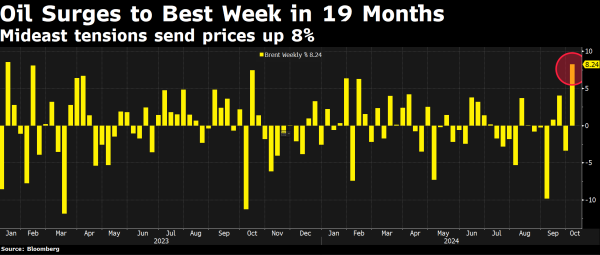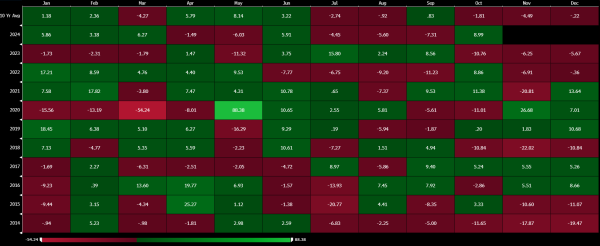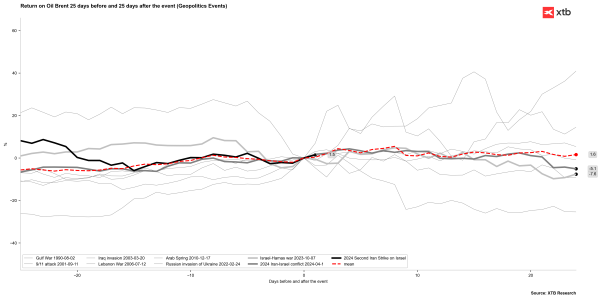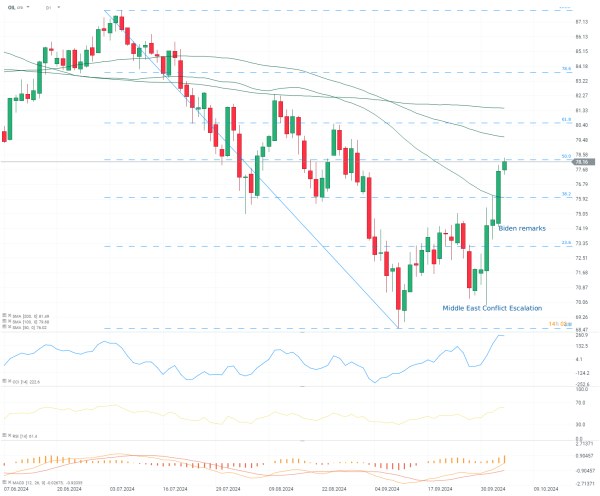Chart of the Day - OIL (04.10.2024)
Oil markets experienced a dramatic surge yesterday, with Brent crude jumping 5% to reach $77.62 a barrel, its highest level in over a month. This sharp increase comes amid escalating tensions in the Middle East and growing speculation about potential Israeli strikes on Iran's oil infrastructure. The benchmark West Texas Intermediate (WTI) crude mirrored this upward trend, settling at $73.71, marking a 5.15% rise for the day. Today oil continues the rally with Brent crude gaining 0.83% to reach $78.16 and WTI crude up over 0.8% to $74.27.
The catalyst for this sudden spike was a comment from US President Joe Biden. When asked about the possibility of Israel striking Iran's oil facilities, Biden stated that "we're discussing that." This remark sent shockwaves through the oil markets, raising fears of potential disruptions to global crude supplies.
Key factors driving the oil price surge include:
- Geopolitical tensions: The ongoing conflict between Israel and Iran has escalated, with Iran's recent missile attack on Israel prompting concerns about retaliatory actions.
- Supply disruption fears: Any attack on Iran's oil infrastructure could significantly impact global oil supply, as Iran is the world's seventh-largest oil producer.
- Strait of Hormuz concerns: Worries about potential blockades in this critical shipping route, through which a third of oil tanker traffic passes, are adding to market jitters.
- Increased risk premium: The heightened geopolitical risks are pushing traders to price in a higher risk premium for oil.

Oil prices have been volatile since the start of the week due to the escalating tensions in the Middle East. Foremost among these is the ongoing geopolitical tension between Israel and Iran, which has escalated following Iran's recent missile attack on Israel. This has prompted concerns about retaliatory actions and their potential impact on oil supply chains. Supply disruption fears are particularly acute given Iran's status as the world's seventh-largest oil producer.
Adding to market jitters are worries about potential blockades in the Strait of Hormuz, a critical shipping route through which a third of global oil tanker traffic passes. The heightened geopolitical risks are pushing traders to price in a higher risk premium for oil, contributing to the overall price increase.
Market analysts are divided on the potential long-term impact of these developments. Some warn that oil prices could spiral even higher if Israel strikes Iranian refineries and Tehran retaliates by attacking other oil fields and refineries in the region. Others, however, point to mitigating factors such as weak demand from China and OPEC+ producers' spare capacity of over 5 million barrels per day, which could help offset potential supply disruptions.
The global implications of this price surge are significant and multifaceted. There are growing concerns about inflation, as any extended rise in energy prices raises the possibility of higher petrol prices and increased gas and electricity bills. Bank of England governor Andrew Bailey highlighted these concerns on Thursday, warning of the "very serious" potential impact and stating that he was watching developments "extremely closely."

Seasonality Chart Source: Bloomberg L.P.
For traders and investors, several key factors will be crucial to watch in the coming days. These include any announcements or actions from Israel regarding potential strikes on Iran's oil infrastructure, Iran's response to potential threats or actions against its oil facilities, and movements in the Strait of Hormuz that could impact oil tanker traffic. Additionally, statements from OPEC+ members regarding potential supply increases to offset any disruptions will be closely monitored, as will global economic data, particularly from China, which could impact oil demand forecasts. Also seasonality will play a big role with October and November being historically weak months for Oil.

While the current surge in oil prices is significant, it's worth noting that the reaction has been far more muted than the response to Russia's invasion of Ukraine in 2022. However, the situation remains fluid, and any further escalation could lead to more dramatic price movements in the coming days and weeks.The biggest spike was historically visible in the first week after the geopolitical tensions started.
The sustainability of this price rally will largely depend on whether the tensions in the Middle East escalate further and lead to actual disruptions in oil supply. As the situation continues to evolve, market participants will need to stay vigilant and prepared for volatility.
OIL (D1 interval)
The Brent Crude contract, represented by the OIL ticker, is approaching the 50% Fibonacci retracement level, which hasn't been a major factor in previous price movements. Key levels to watch are the 100-day SMA, followed by the 61.8% Fibonacci retracement, which has acted as resistance before. For bears to take control, the 38.2% Fibonacci retracement level, aligning with the 50-day SMA at $76, is the critical price point to break. Currently, all oscillators show clear bullish divergence on both daily and weekly timeframes, although the MACD has yet to issue a buy signal on the weekly chart. Source: xStation
